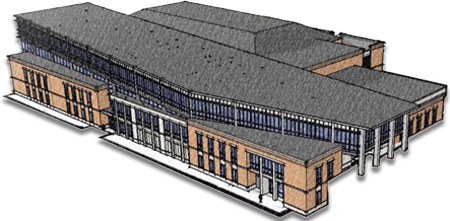Campus Additions Are a Blueprint for Success
Providing current and future students with excellent campus facilities is a major part of RU’s strategy for growth and quality in the years ahead. $212 million in building and remodeling projects either already in progress or on the drawing board will give the campus a new look by 2014.
The steel superstructure for the new $44 million building for the College of Business and Economics (COBE) is steadily rising on the hill behind Moffett Hall. Half a mile away from the construction site, inside the David E. Armstrong Complex, Director of Facilities Planning and Construction Roy Saville is poring over blueprints and reviewing contract documents. But most have nothing to do with the COBE project.

An architectural rendering of the new Fitness and Wellness Center.
Saville and his colleagues are focused already on RU’s next two major capital projects, both expected to begin within two years: a $32 million, 112,000-square-foot Fitness and Wellness Center for students and a $49 million, 115,000-square-foot Center for the Sciences.
“We’re in the midst of a building boom,” said Vice President for Finance and Administration Richard
Alvarez, noting that the university has approved a total of $212 million for expansion and upgrades.
Renovation and expansion have been a key part of the university’s strategy for ensuring that students have high-quality academic, recreational and residential spaces. In 2009, the Dedmon Center reopened after a major renovation that included a new roof and other upgrades to support the Highlanders’ NCAA Division I intercollegiate athletics program. Later that year, Young Hall underwent a major renovation that made it one of the most technologically advanced academic buildings in the nation, with non-traditional seating to facilitate collaborative learning, Smartboard interactive displays and high-definition digital monitors, portable whiteboards and podiums and touch-screen control panels.
The new Fitness and Wellness Center will be four stories tall and constructed of brick and sweeping glass windows. Located off Jefferson Street, it will provide students with state-of-the-art recreational, wellness and exercise facilities. Saville said it will feature an indoor graded track that will wind through two levels of the building, making RU one of only a few universities nationwide with such a facility for running and walking.
A 10,000-square-foot Multiple Activity Court (MAC) will accommodate roller hockey and other strenuous sports. Ringed by shock-absorbing, protective walls, the MAC has an added benefit: It can also be configured to accommodate events such as large banquets, Saville said.
The building will also include two racquetball courts, weight rooms stocked with exercise equipment and free weights, a classroom for wellness-oriented instruction and office and support space. RU Outdoors, which provides students with canoes and other equipment for outdoor and wilderness activities, will be based in the new complex.
Construction is expected to begin in late fall or early winter, Saville said, with an opening planned for fall 2013.
Work on the Center for the Sciences is expected to be under way by the time the Fitness and Wellness Center opens.
The multilevel structure, which will house laboratory, research and classroom space, is being designed with sustainability features to minimize energy costs and serve as “best practices” demonstration projects. For example, it might have a “green” roof. Rather than asphalt shingles or other composite materials, the roof could be a garden of low-growing, succulent, drought-resistant shrubbery, Saville said. The roof would not only insulate the building, it would promote atmospheric carbon exchange. It could also accommodate photovoltaic panels and possibly a small windmill for generating electricity.
Designed by Washington, D.C.-based architectural firm EYP, the project includes a 15-month design phase and a 20-month construction phase, which would put the opening in July 2014, Saville said. Once that happens, the university plans to immediately begin a major renovation of Curie Hall, which will complete the College of Science and Technology’s master plan to expand and optimize its campus space.
When students return this fall, 348 students will move into the renovated Madison and Jefferson residence halls, a $10 million project and a “much-needed, contemporary facelift,” Saville said. Both buildings now have air conditioning, upgraded electrical and plumbing systems and new fire protection and sprinkler systems. Moffett Hall is scheduled to begin a similar overhaul this summer, with completion set for fall 2012.
“From new capital projects to major renovations, we are making transformational changes in our facilities, all of which are designed to provide our students with a high-quality university experience,” Alvarez said.